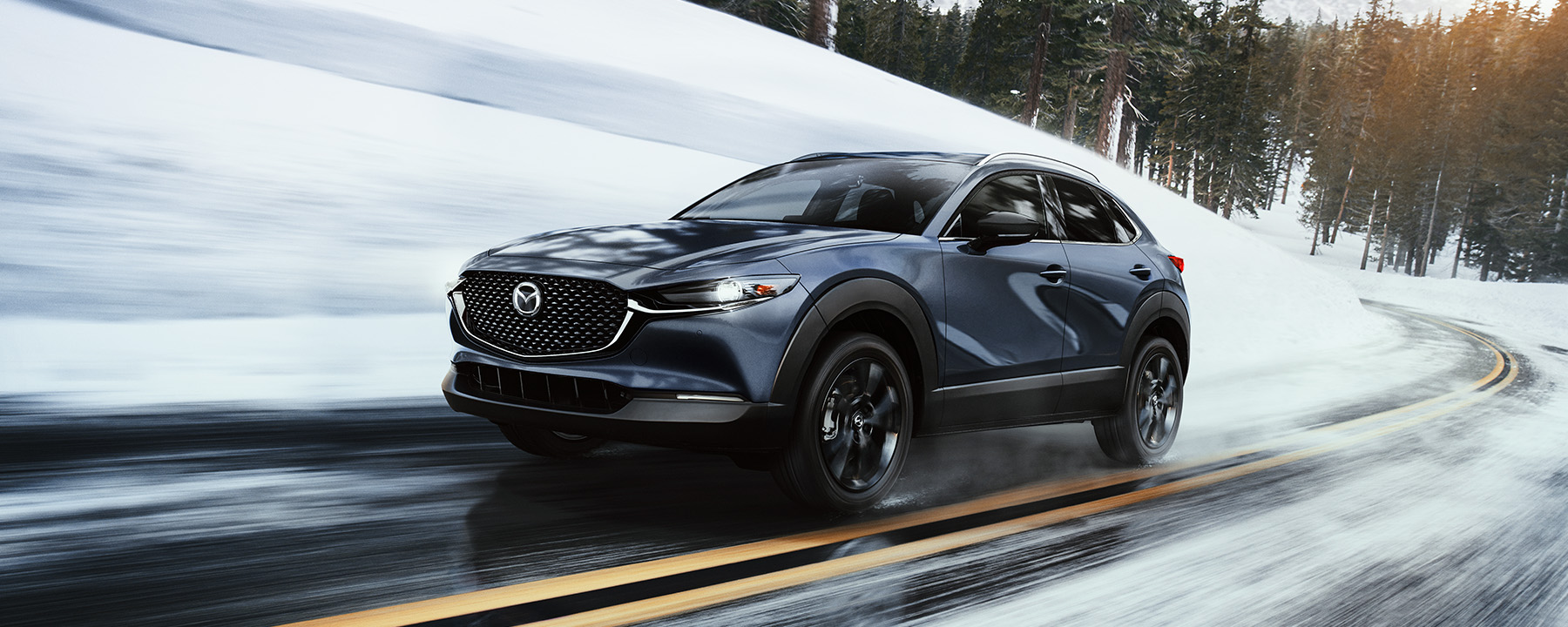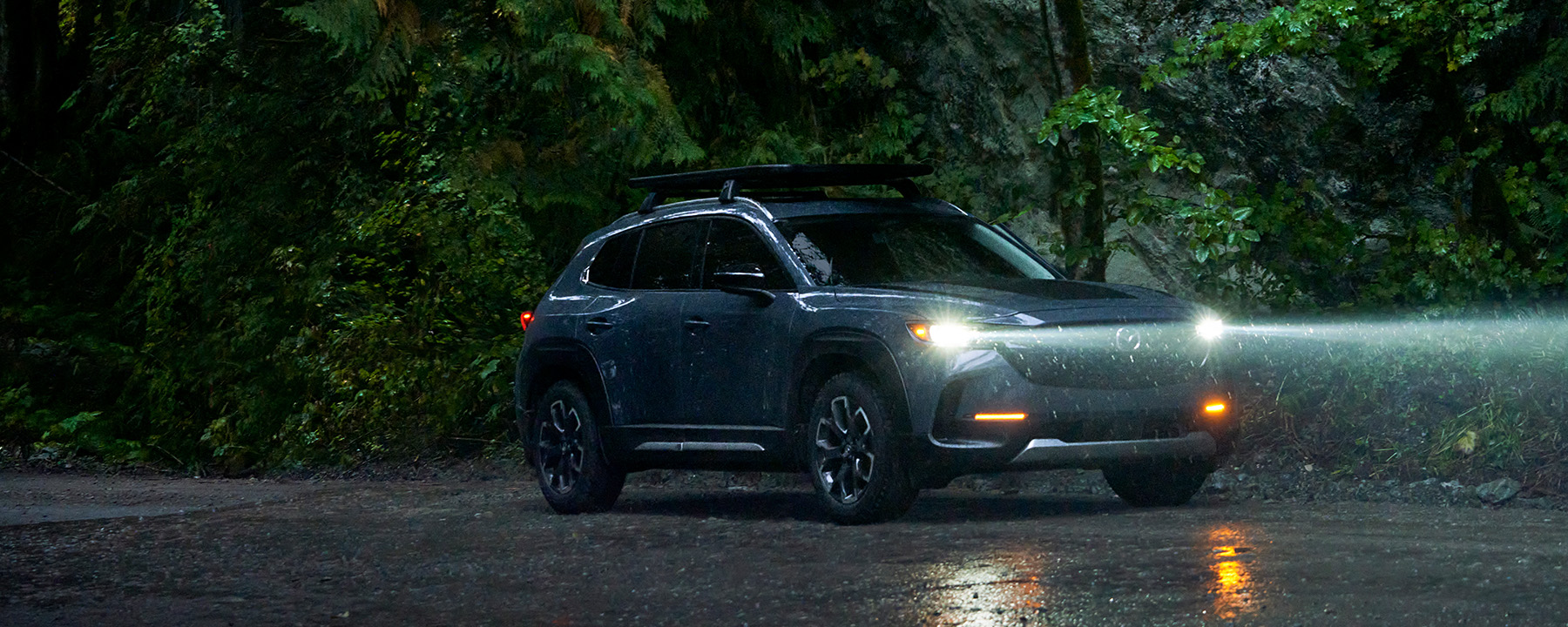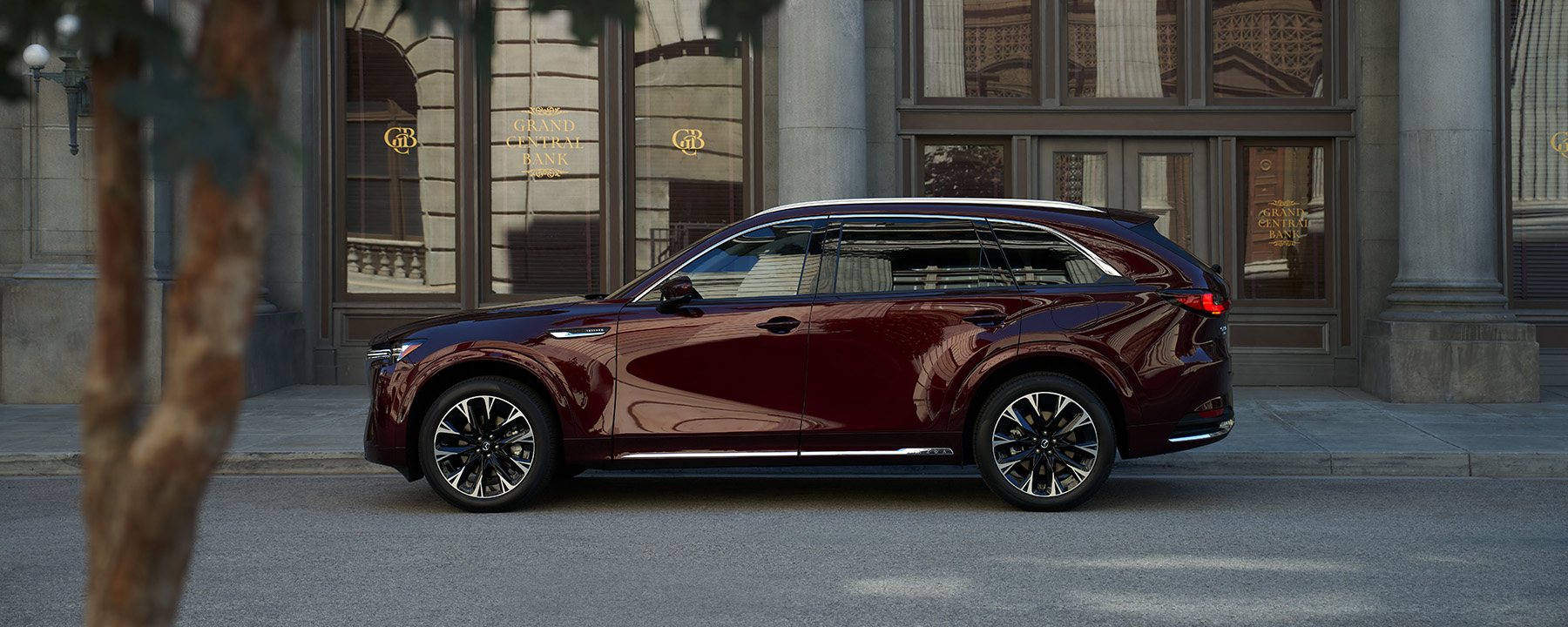Minivan vs. SUV
Let’s quickly compare minivans vs. SUVs and look at what exactly these differences entail so you can make a more informed decision about your next vehicle purchase.

Comparing minivans vs. SUVs requires painting in broad strokes
When weighing the pros and cons of minivans and SUVs, it can be difficult to come down one way or the other on which vehicle type is the “winner” in certain categories. That’s because, while trends do occur across vehicle types, different models within those types can vary significantly.
Let’s use some of Mazda’s crossover SUVs as an example and look at seating and cargo space.
● The Mazda CX-30 is a sporty subcompact crossover SUV that seats up to 5 and has a 20.2 cubic foot cargo area (45.2 cubic feet when you fold down the rear seats).
● The Mazda CX-50 is a compact crossover SUV built for the outdoors that also seats up to 5 but has a 31.4 cubic foot cargo area (56.3 cubic feet when you fold down the rear seats).

2024 Mazda CX-30 2.5 S Turbo Premium Plus with options shown.
As you can see, there’s a lot of variety here even within these three Mazda crossover SUVs. And again, we’re looking at only seating capacity and cargo space — not performance, amenities, price, etc. The differences can really compound.
Keeping this in mind, we’ve tried to split our comparisons into two categories. In the first; “differences that matter,” we discuss differences between minivans and SUVs where we're able to draw some rough conclusions. In the second; “differences that split hairs,” there is often too much variety within models to make strong recommendations either way, and we speak to why.
Minivans vs. SUVs: Differences that matter
Ground Clearance
SUVs, including crossovers, tend to have higher ground clearance than minivans. Higher ground clearance can make it easier to drive in snowy conditions and off-road terrain. The higher ground clearance — and higher ride height — of SUVs and CUVs relative to cars can also give drivers the feeling of having better visibility. Finally, if you have kids who are still in car seats, the extra height can save you from having to constantly bend over when fitting a car seat or buckling in your little ones.
Meanwhile, the lower ground clearance of minivans has its own advantages. A lower ride height means a lower center of gravity, which can make drivers feel more connected to the road. Lower ground clearance also means lower step-in and cargo-loading height, which can be very helpful if you frequently carry heavy bags and sports equipment or have passengers who need mobility support, such as elderly passengers, or little kids who are climbing into the car on their own.
Preproduction 2024 Mazda CX-50 2.5 Turbo Meridian Edition with Apex Package and options shown. Production model will vary. Use care and reduce speed when traveling on rough/uneven roads.
Performance in difficult terrain and snow
As we just saw, the higher ground clearance of SUVs and crossovers gives them a leg up over minivans if you regularly need to drive in snow. But crossovers and SUVs also have a distinct advantage over most minivans in this area in another way: their drive systems.
Namely, many minivans typically use front-wheel drive (FWD), which can handle snowy and slippery inclines to some extent, but not as efficiently as all-wheel drive (AWD). There are minivans that have AWD, but you’re more likely to find it offered in a crossover SUV. Meanwhile, traditional SUVs are typically offered with four-wheel drive (4WD), which comes in handy when driving in truly rugged, uneven terrain.
All in all, while there are more “rugged” minivan options out there if you need a vehicle that’s adaptable to less-than-ideal driving conditions or off-pavement travel, SUVs and CUVs offer distinct advantages.
You can learn more about this in our articles: AWD vs. 4WD [and Do I Need a Vehicle with AWD?]
Towing Capabilities
While many minivans and CUVs do provide towing capabilities, traditional SUVs are built with the need for towing in mind. This is where the weight and power behind a traditional SUV come in handy. There are many factors that go into making a vehicle a good towing vehicle, including chassis design, drive system, braking power, and more. When it comes to towing, traditional SUVs tend to be better equipped in these areas.
Sliding doors
Sliding doors are a defining feature of minivans and provide some real practical benefits. Coupled with the minivan’s low ground clearance, sliding doors make it easier for little kids or individuals with mobility needs to get in and out of the vehicle. Sliding doors also offer easier access to the 3rd row, which can be harder to get to in SUVs and CUVs.
Sliding doors also don’t open as far out as hinged doors, so you’re less likely to:
● ding a neighboring vehicle when you’re opening your door.
● have limited access to your car’s interior just because someone parked close to you.
● have your open door hit by a moving vehicle.
Finally, if you’ve put down your seats and are using the rear of your vehicle for transporting items, sliding doors can provide more open access to cargo.
Buying Options
With their growing popularity in the U.S. market, there are simply more new models of SUVs to choose from than new minivan models. This naturally extends to there being more hybrid, plug-in hybrid, and all-electric choices in CUVs and SUVs compared to minivans.
2024 Mazda CX-90 3.3 Turbo S Premium Plus with options shown.
Aesthetics
Beauty is in the eye of the beholder, but most beholders tend to find the sportier, sleeker looks of SUVs more beautiful than the more utilitarian appearance of minivans. While we don’t feel there’s any need to lean into the stigma that minivans receive here, appearance is still a very compelling factor for so many buyers, so it’s worth stating.
Minivans vs. SUVs: Differences that split hairs
-
Minivans are known for their ability to haul people and cargo and can be ideal if you regularly need to transport large amounts of people and cargo simultaneously. However, if you want an SUV, you’ll likely also find options that will meet your cargo space needs.
Minivans tend to have floors that are lower to the ground, giving you an overall larger storage space in which to stow your belongings. This is true and only the largest models of SUVs can have similar cargo space to minivans.
As with cargo space, minivans are typically labeled the “winners” when it comes to passenger room. Minivans do typically come with a third row and can seat 7-9 passengers, depending on the model, but many mid to full-size SUVs can also accommodate up to 8 passengers. 9-passenger SUVs do exist but are quite rare. Of course, seating numbers offer only a partial story; you’ll also want to check for headroom and legroom. SUVs typically still have less headroom and legroom in their third-row seats than minivans , but again, check the specs of the models you’re interested in.
-
The consensus seems to be that SUVs are trendier and possess more “cool factor” than minivans , but when it comes to technology features, most new versions of both minivans and SUVs come standard with a range of available tech features designed to entertain, improve comfort, and assist with performance, plus a variety of safety features designed to protect.
Typically, the newer the vehicle, the more tech and safety amenities come standard, but again, these features vary from model to model, and you’ll want to evaluate them — especially the tech features — based on your needs and circumstances. As a simple example, if you use your vehicle to transport a lot of cargo, maybe you don’t care if your vehicle has 4 USB ports (or if they are type A or C); if you use it to transport a lot of teens, maybe you do.
Ultimately, comparing minivans vs. SUVs when it comes to tech and safety won’t be as helpful as comparing specific models you’ve already vetted for the “differences that matter” portion of this article.
It can be helpful to look at vehicle safety ratings from trusted organizations like the IIHS and the NHTSA. Mazda’s vehicles include an array of safety features, and every Mazda vehicle tested by the IIHS in 2023 won an award – including the CX-30, CX-5, and CX-50 crossover SUVs. Learn more about Mazda safety features, including the i-ACTIVSENSE® safety suite.
-
Looking at baseline prices of minivans vs. SUVs, there is a pretty wide variety between models and brands. On top of that, SUVs and minivans of each model can come in a variety of different trims. Sticker price is also just one factor of many. You’ll also want to think about operational costs, insurance costs, how long you plan to keep the vehicle (resale value), whether you plan on buying used or leasing, and so on.
Ultimately, there are so many types of SUVs and minivans available that finding one or the other that fits your budget should be possible. To help you get started, check out the Alternative Fuels Data Center vehicle cost calculator. Or, if you’re interested in a Mazda, see our build and pricing page.
-
Minivans have historically had the edge on SUVs in terms of fuel economy. In part, this is because minivans are more aerodynamic, and have smaller, less aggressive tires. They are also typically lighter due to their car-based platform construction, in which the body of the vehicle and the chassis are constructed as one unit, whereas traditional SUVs are built on a truck-based platform, in which the body of the vehicle and the chassis are built separately and then attached. Car-based platforms are typically lighter than truck-based platforms , when all other factors are equal.
However, crossover SUVs (abbreviated CUVs or simply crossovers), like minivans, are built on a car-based platform, making them lighter than their traditional SUV counterparts. Add to this the growing number of hybrid, plug-in hybrid, and battery-electric options for both SUVs and minivans and comparing fuel efficiency gets even more complicated.
So again, as with the other categories in this section, it’s best to compare your fuel economy options on a model-by-model basis and not across the broader categories of SUVs vs. minivans.
2024 Mazda CX-90 PHEV Premium Plus with options shown.
Mazda: Vehicles for the Whole Family
Whether your next adventure involves exploring a new city or the great outdoors, we have the vehicle that can transport you, your loved ones, and your belongings where you want to go, all in comfort and style.
From our sophisticated CX-5 to our powerfully efficient PHEVs such as the CX-90 or CX-70 and everything in between, when it comes to finding the perfect vehicle for your family, Mazda has you covered.
Explore Mazda’s CUVs to find your next ride, then visit your local dealer to take one for a test drive or build your own Mazda online today.
This article is intended for general informational purposes only and is based on the latest competitive information available at the time of posting. Information herein is subject to change without notice and without Mazda incurring any obligations. Please review a variety of resources prior to making a purchasing decision. Visit Resource Center for more articles.
























